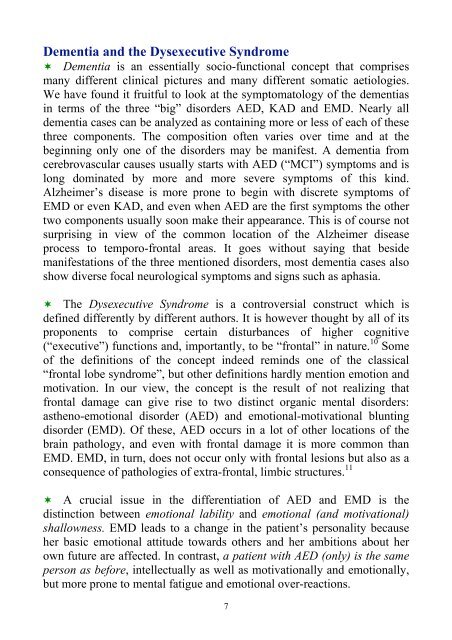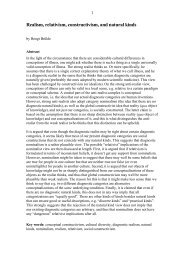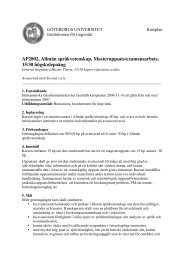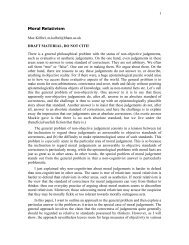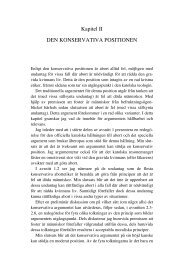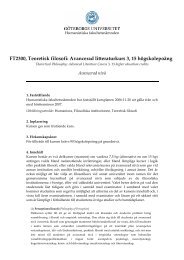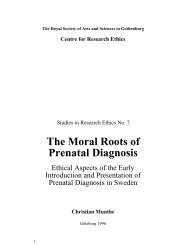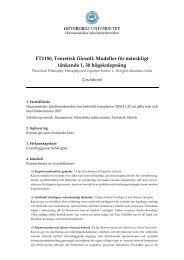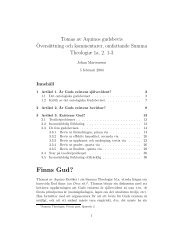Memory, emotion and brain injury Memory, emotion and brain injury
Memory, emotion and brain injury Memory, emotion and brain injury
Memory, emotion and brain injury Memory, emotion and brain injury
Create successful ePaper yourself
Turn your PDF publications into a flip-book with our unique Google optimized e-Paper software.
Dementia <strong>and</strong> the Dysexecutive Syndrome<br />
Dementia is an essentially socio-functional concept that comprises<br />
many different clinical pictures <strong>and</strong> many different somatic aetiologies.<br />
We have found it fruitful to look at the symptomatology of the dementias<br />
in terms of the three “big” disorders AED, KAD <strong>and</strong> EMD. Nearly all<br />
dementia cases can be analyzed as containing more or less of each of these<br />
three components. The composition often varies over time <strong>and</strong> at the<br />
beginning only one of the disorders may be manifest. A dementia from<br />
cerebrovascular causes usually starts with AED (“MCI”) symptoms <strong>and</strong> is<br />
long dominated by more <strong>and</strong> more severe symptoms of this kind.<br />
Alzheimer’s disease is more prone to begin with discrete symptoms of<br />
EMD or even KAD, <strong>and</strong> even when AED are the first symptoms the other<br />
two components usually soon make their appearance. This is of course not<br />
surprising in view of the common location of the Alzheimer disease<br />
process to temporo-frontal areas. It goes without saying that beside<br />
manifestations of the three mentioned disorders, most dementia cases also<br />
show diverse focal neurological symptoms <strong>and</strong> signs such as aphasia.<br />
The Dysexecutive Syndrome is a controversial construct which is<br />
defined differently by different authors. It is however thought by all of its<br />
proponents to comprise certain disturbances of higher cognitive<br />
(“executive”) functions <strong>and</strong>, importantly, to be “frontal” in nature. 10 Some<br />
of the definitions of the concept indeed reminds one of the classical<br />
“frontal lobe syndrome”, but other definitions hardly mention <strong>emotion</strong> <strong>and</strong><br />
motivation. In our view, the concept is the result of not realizing that<br />
frontal damage can give rise to two distinct organic mental disorders:<br />
astheno-<strong>emotion</strong>al disorder (AED) <strong>and</strong> <strong>emotion</strong>al-motivational blunting<br />
disorder (EMD). Of these, AED occurs in a lot of other locations of the<br />
<strong>brain</strong> pathology, <strong>and</strong> even with frontal damage it is more common than<br />
EMD. EMD, in turn, does not occur only with frontal lesions but also as a<br />
consequence of pathologies of extra-frontal, limbic structures. 11<br />
A crucial issue in the differentiation of AED <strong>and</strong> EMD is the<br />
distinction between <strong>emotion</strong>al lability <strong>and</strong> <strong>emotion</strong>al (<strong>and</strong> motivational)<br />
shallowness. EMD leads to a change in the patient’s personality because<br />
her basic <strong>emotion</strong>al attitude towards others <strong>and</strong> her ambitions about her<br />
own future are affected. In contrast, a patient with AED (only) is the same<br />
person as before, intellectually as well as motivationally <strong>and</strong> <strong>emotion</strong>ally,<br />
but more prone to mental fatigue <strong>and</strong> <strong>emotion</strong>al over-reactions.<br />
7


